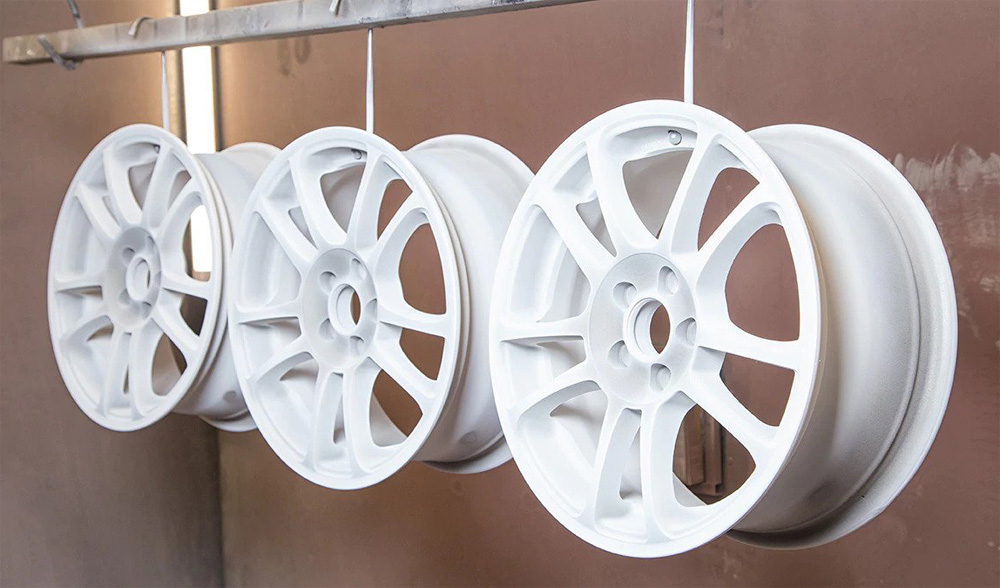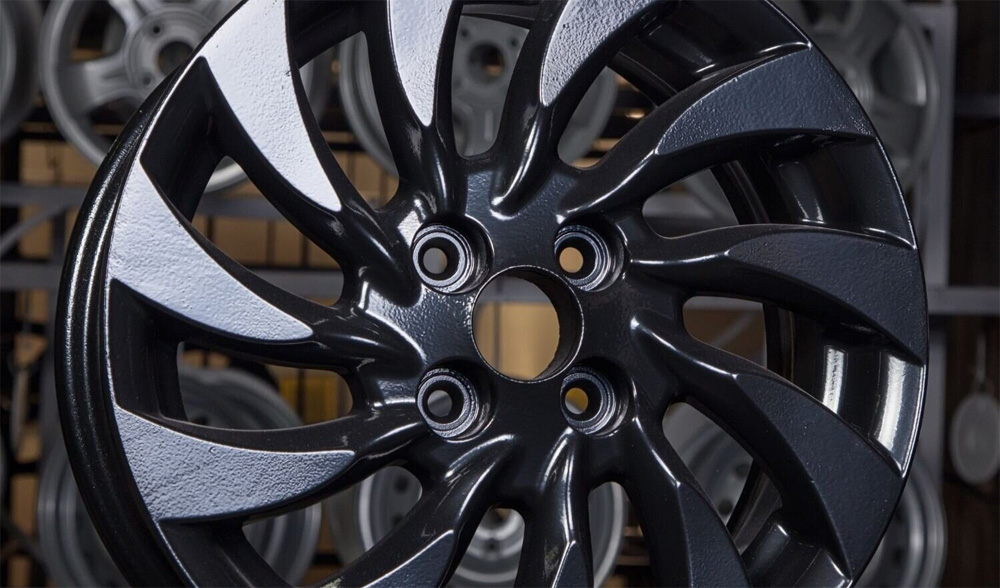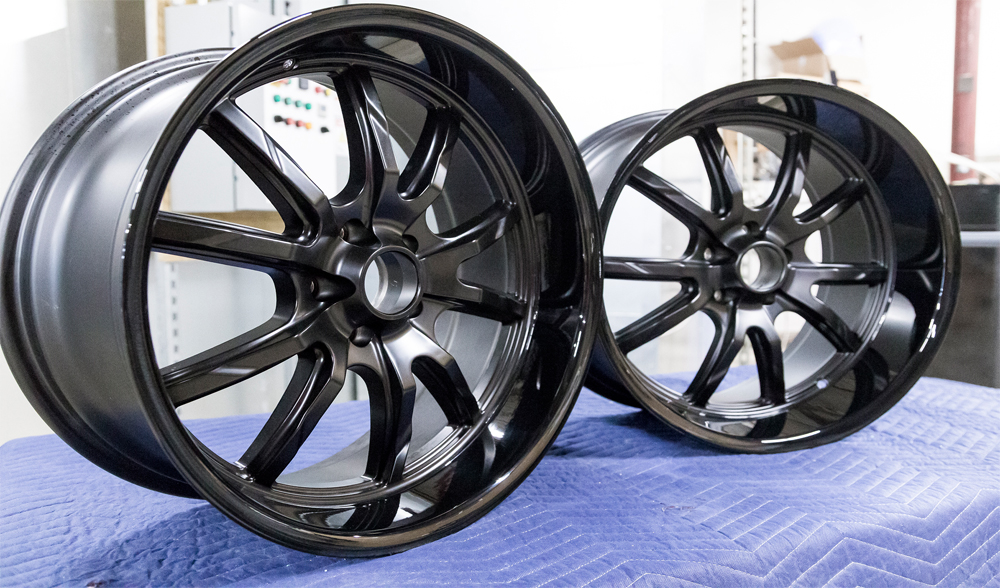Powder coating presents an excellent opportunity to enhance the visual appeal of your wheels without breaking the bank on new replacements. This process entails the application of a dry powder onto the rim’s surface through an electrostatic method, followed by a heat-curing procedure. The powder consists of a polymer base infused with curing additives, leveling agents, pigments, resin, and flow modifiers. When powder coating rims, the blended powder adheres to the electrically charged surface, the wheels undergo a baking process in an oven or kiln. As the powder melts, it forms a uniform coating over the wheels, which subsequently solidifies into an exceptionally durable, smooth surface as it cools.
By opting for powder coating, you can avoid the expenses associated with purchasing new custom rims when your current ones begin to appear worn out. This technique not only enhances the durability of your wheels but also provides superior resistance against flaking and chipping compared to traditional painting methods. The powder-coated surface forms a strong bond with the metallic surface of your rims, revitalizing their appearance and giving them a fresh, rejuvenated look.

Advantages and Disadvantages
Before exploring alternative methods to enhance the appearance and durability of your rims, it’s crucial to familiarize yourself with the advantages and disadvantages of powder coating.
Advantages
1. Significant Resistance
Powder coating offers remarkable protection against chipping, flaking, and corrosion caused by debris, salt, road grime, and various environmental factors. By creating a non-porous surface, it provides enhanced safeguarding for your rims, surpassing the protective capabilities of conventional paint.
2. Enhanced Longevity
When powder coating rims, they are subjected to high temperatures in an oven, allowing the coating to tightly bond with the rim surface and significantly enhance durability. This results in a thicker layer of coating that offers consistent coverage. In fact, powder coating has the potential to last up to three times longer than standard paint, providing an extended lifespan for your rims.
3. Eco-friendly
Unlike certain automotive paints, the application process of powder coating does not release volatile organic compounds (VOCs). This not only ensures a safer breathing environment but also helps in preserving the ozone layer. Moreover, any excess powder used during the coating can be easily recycled for future applications, making it an environmentally friendly choice. Unlike leftover paint and overspray, powder coating has a long shelf life, minimizing waste and promoting sustainability.
4. Improved Coverage
One of the notable advantages of powder coating rims over regular paint is its ability to be applied on rims of any design, regardless of their intricate features, without affecting other areas of the vehicle. The electrostatic application method, combined with the curing process, enables the coating to reach even the most challenging nooks and crannies of the rim, ensuring comprehensive coverage and a uniform finish.
5. Economical
Although the initial cost of powder coating is similar to painting, the true savings lie in the long-term durability of the coating.
6. Accelerated Curing
Compared to paint, powder coating requires a significantly shorter curing time, achieving maximum durability within minutes rather than weeks.
7. Compatible with Metals
Powder coating can be applied to a wide range of metal materials, such as brass, steel, aluminum, and stainless steel.
8. Less Waste Produced
Powder coating rims generates less wasted product compared to paint due to the absence of solvents, which prevents overspray from evaporating.
Disadvantages
1. Color-related difficulties
Achieving the desired final hue or tone can be a challenging task when it comes to powder coating. Special paint effects such as gradients or stripes can be particularly difficult, and in some cases, even impossible to achieve with this process. Additionally, recycled powder may contain traces of other colors used in previous coating applications, leading to potential cross-contamination.
2. Issues with Wheel Surface Thickness
If your goal is to create a thin surface with a specific appearance, the powder-coating process may not be the ideal choice. Powder coating typically results in a thick finish that offers exceptional durability and resilience, making it well-suited for enduring harsh conditions.
3. Rim Grinding is Required
To ensure effective bonding of the coating, the powder-coating process may require grinding of your rims. If your rims simply need a touch-up on an existing powder coat, this grinding task can be relatively minor in nature.
4. A Reduced Control Over Smoothness
Occasionally, the heat generated during the baking process can lead to surface inconsistencies as the electrostatic process fails to establish a strong bond.
5. Challenges associated with thicker components.
The curing process for larger parts takes longer due to the need for sufficient heating and cooling time. As a result, the completion of these larger parts requires additional time, which can impact the pricing of the powder coating service.

Powder Coating or Painting: Which is Better?
Choosing to paint instead of opting for powder coating rims will result in a surface treatment solution that is only temporary. Here are several reasons why paint is considered inferior to powder coat:
- Paint is prone to chips, peels, and scratches.
- It lacks durability.
- premature corrosion caused by road conditions.
- It only serves as a temporary solution.
- Coverage on certain intricate rims can be challenging.
- It lacks cost-efficiency.
Powder coating rims offers a high-quality finishe that is both durable and easy to apply. While it may have a higher cost compared to regular paint, the investment is well worth it as it provides long-lasting protection for your rims. By regularly cleaning the rims with water and soap, you can maintain their pristine condition, ensuring they retain their value when it comes time to sell. This makes powder coating a wise investment with a great return on investment.
Colors
Powder coatings offer a diverse range of color options, including black, white, silver, red, yellow, gold, orange, and many more. With hundreds of colors and shades available, you have the freedom to choose your preferred color. Reputable powder-coating experts can provide color charts to assist you in finding the perfect shade for your rims.
Cleaning rims in brighter colors can pose challenges due to the potential accumulation of tar and other substances from the road, which can darken their appearance when cleaned. To maintain their good condition, it is recommended to regularly wash them with water and soap. It is crucial to steer clear of acid wheel cleaners and other cleaning agents containing strong chemicals. By adhering to these practices, you can effectively preserve the vibrant look of your rims.
Black remains a popular color choice among vehicle owners, offering a wide array of finishes such as candy, wrinkle, high gloss, satin, and flat. It is a preferred option due to its durable nature, consistent high gloss, and ability to conceal minor surface flaws effectively.
Matte or Gloss
Matte and gloss powder coating finishes have distinct differences. Matte finishes appear rough and do not reflect light; instead, they scatter it. However, matte finishes can be more challenging to keep clean and often have a tendency to appear dirty, which is important to consider for resale purposes.
What is the Cost for Powder Coating Rims?
The price of powder coating rims can vary due to factors such as demand and the cost of supplies. On average, the cost of powder coating rims typically ranges from $400 to $1200 for a set of four wheels. Larger wheels or those with curb rash may require additional refinishing work, which can increase the overall cost of the powder coating service.
How Long Will It Last?
Powder coating rims is a wise choice to make them last longer. The longevity and quality of your powder coating finishes depend on your choice of provider. Opting for expert-level powder coating work can result in coatings that last between 15 to 20 years. However, this predicted lifespan is influenced by factors such as wear and tear, exposure to corrosive agents, and the usage patterns of your vehicle. When the coating finishes are applied with expertise, you increase your chances of maintaining good resale value.
Powder Coat Aluminum Wheels?
The practice of powder coating rims is suitable for various metal wheel materials, including aluminum. However, due to the generally smooth nature of aluminum surfaces, it is necessary to roughen the surface for the coating to adhere properly. Additionally, aluminum surfaces typically have a thin layer of aluminum oxide that needs to be removed before applying the powder coating. Once the powder coating is correctly applied to aluminum, it can have a lifespan of up to 20 years.
Can I Do It at Home?
Achieving optimal results when applying powder coating at home can be challenging unless you possess the necessary equipment and expertise. Without the proper tools and knowledge, it may be difficult to achieve the exact color and texture of a perfect powder-coating finish. Experienced providers, on the other hand, possess the necessary know-how and facilities to carry out the task correctly, using appropriate procedures to ensure a high-quality outcome.

Powder Coating Process
The following are the typical process of powder coating rims:
Base Spray – In the paint booth, the wheel is suspended and electrically charged. It is then sprayed with a base layer, which serves as a foundation coat to create a smooth surface.
The Quick Bake – Subsequently, the wheel is placed inside an industrial oven and subjected to a temperature of 400 degrees Fahrenheit (204 degrees Celsius) for approximately 20 minutes. This application of heat ensures that the coating adheres firmly to the surface of the wheel.
Cool Down & Clear Coat – After being heated in the oven, the wheel is taken out and left to cool down to room temperature. Once it has cooled, the wheel is then returned to the coating booth to apply a clear coat. Clear powder coats typically have a white appearance before being baked.
The Big Bake – Once the clear coat has been applied, the wheel is placed back into the oven for a baking process that typically lasts between 35 to 45 minutes. This step helps to cure and solidify the clear coat, ensuring its durability and providing a final protective layer for the wheel.
Rubber & Rest – Once the wheel has fully cooled, the powder coater carefully removes any hooks, tape, and center plugs that were utilized during the process.
What to Avoid
There are several factors that can impact the quality of your powder-coated finish. To begin with, it is essential to thoroughly eliminate any impurities and properly prepare the surface before applying the powder. It’s crucial to strike the right balance and avoid using excessive or insufficient amounts of powder. Additionally, it’s important to adjust your equipment settings accurately to ensure optimal results. Following the correct powder coating cure procedure is crucial as well, as failure to do so can lead to under-curing or over-curing.
Conclusion
Powder coating rims offers numerous benefits, and although it may require a financial investment, it is truly worth it. Not only does it enhance the appearance of your vehicle, but it also provides you with long-lasting rims. While the temptation to cut costs may arise when opting for a DIY powder coat, it is still advisable to seek the assistance of a professional for the optimal outcome.





